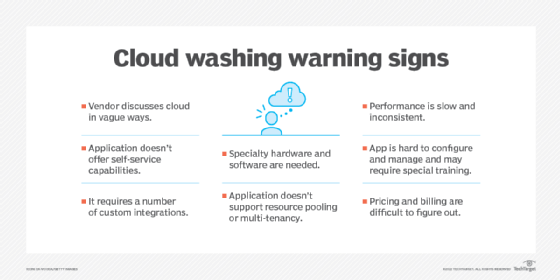cloud washing
What is cloud washing?
Cloud washing (also spelled cloudwashing) is the purposeful and sometimes deceptive attempt by a vendor to rebrand an old product or service by associating the buzzword cloud with it.
Marketers often use the term cloud when talking about technology, whether or not the products being discussed are true cloud-native applications that fit the cloud computing paradigm. In some cases, companies will port their legacy, on-premises software to virtual environments in centralized data centers and slap on the cloud label. They can do this because many users don't understand the difference between virtualized and cloud-native software.
The word cloud can be ambiguous. As a result, the industry tends to favor the term cloud computing when referring to services delivered over the internet. At the same time, the terms cloud and cloud computing are often used interchangeably; vendors use either term for anything delivered over the internet. If a component of an offering relies on the internet to work, the vendor feels justified in adopting the cloud or cloud computing label.
Cloud computing explained
In 2011, the National Institute of Standards and Technology (NIST) published an official definition of cloud computing in an attempt to solve this issue. That definition reads as follows:
"Cloud computing is a model for enabling ubiquitous, convenient, on-demand network access to a shared pool of configurable computing resources (e.g., networks, servers, storage, applications, and services) that can be rapidly provisioned and released with minimal management effort or service provider interaction."
Although NIST's cloud computing definition is more than 10 years old, it still applies today. The Institute also outlined five characteristics of cloud computing:
- on-demand self-service that lets users obtain resources without human assistance;
- broad network access using a range of standards-based devices;
- resource pooling based on a multi-tenant architecture that enables resources to be dynamically assigned and reassigned;
- rapid elasticity that enables cloud services to be easily scaled and released according to demand; and
- measured services that automatically control and make the most of resource use based on an abstracted metering capability.
Cloud-native applications vs. cloud-washed apps?
There are distinct differences between cloud-native applications and ones that are the subject of cloud washing.
Cloud-native applications
Cloud-native apps are developed and optimized for a cloud computing architecture and cloud platforms. The applications are hosted and run in the cloud. They take advantage of the inherent characteristics of a cloud computing software delivery model.
Cloud-native applications are container-based and dynamically orchestrated. They use standards-based application programming interfaces to connect microservices, which break down the application into independent modules. The cloud-native software can capitalize on the cloud computing framework and cloud infrastructure. The resulting applications are reliable, portable and easy to manage.
Cloud software is usually described as one of the three cloud computing models: software as a service (SaaS), platform as a service (PaaS) or infrastructure as a service (IaaS). SaaS, PaaS or IaaS are a key part of any cloud-native application.
Cloud-native applications also provide greater visibility, portability and scalability at the microservices level.

Cloud-washed application warning signs
A cloud-washed application cannot take advantage of the cloud computing framework. As a result, it might come with any of the following limitations:
- The application does not support resource pooling or multi-tenancy.
- The application requires custom integrations, special hardware or software.
- Usability, performance and security are inconsistent among users and devices.
- The application isn't easy to configure, customize or scale.
- Application updates and improvements are few and far between.
- The application pricing and billing structure is complex.
- Basic operations are slow and cumbersome.
- Setting up and configuring the application requires special training or personnel.
- The application lacks on-demand self-service capabilities.
Vendors that engage in cloud washing often overuse the term cloud in their marketing material. They refer to their products as "cloud-based" and "cloud-enabled" to make them sound like they are cloud-native applications when they aren't.
Cloud washing has been compared to greenwashing, the rebranding of products and services as being friendly to the environment and part of the green cloud. In both instances, the word "wash" means to apply a thin layer of paint to freshen up an existing product or service to make it look new. In this case, the paint is a marketing message.
Learn more about what it means to be cloud native.






